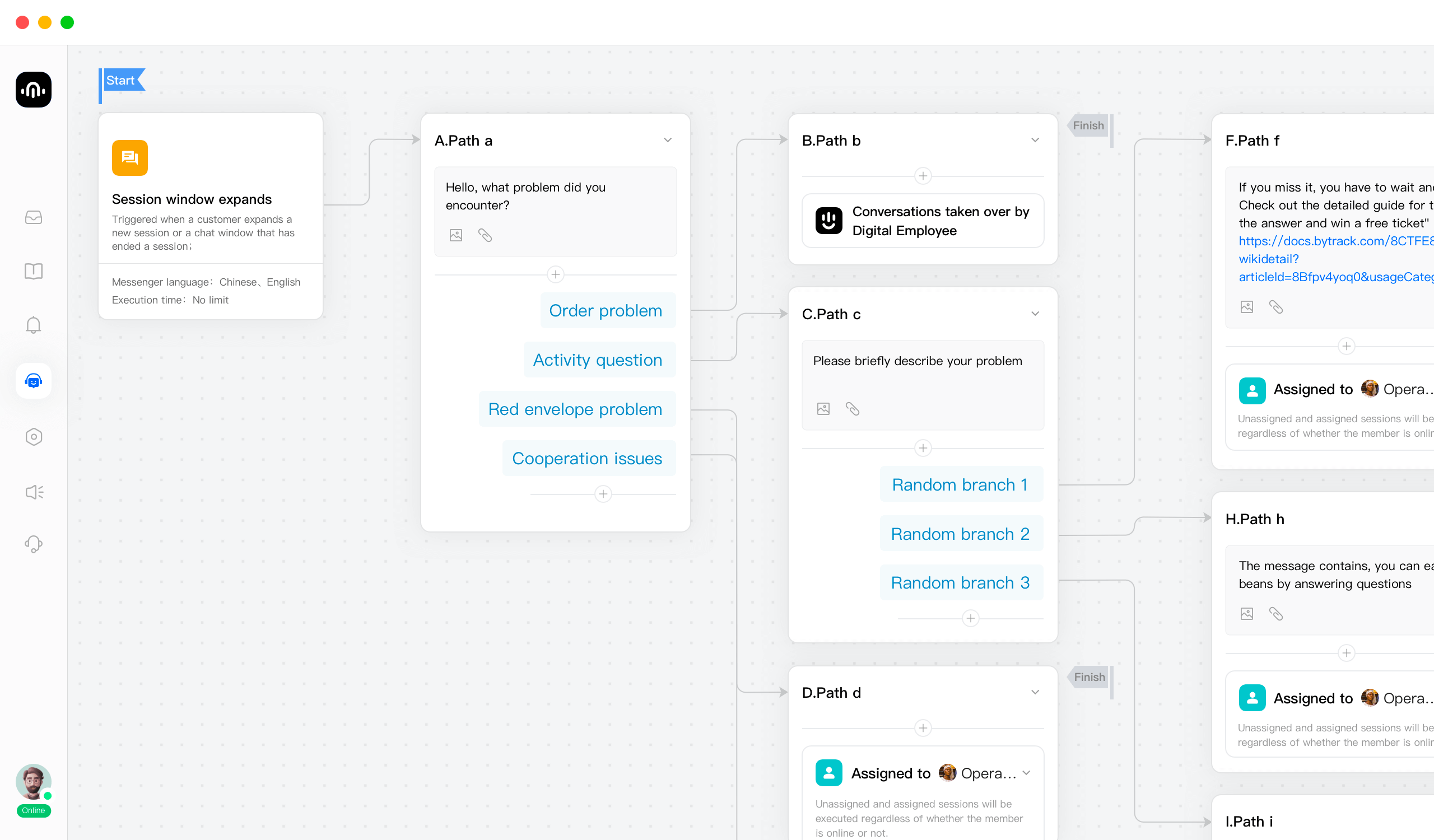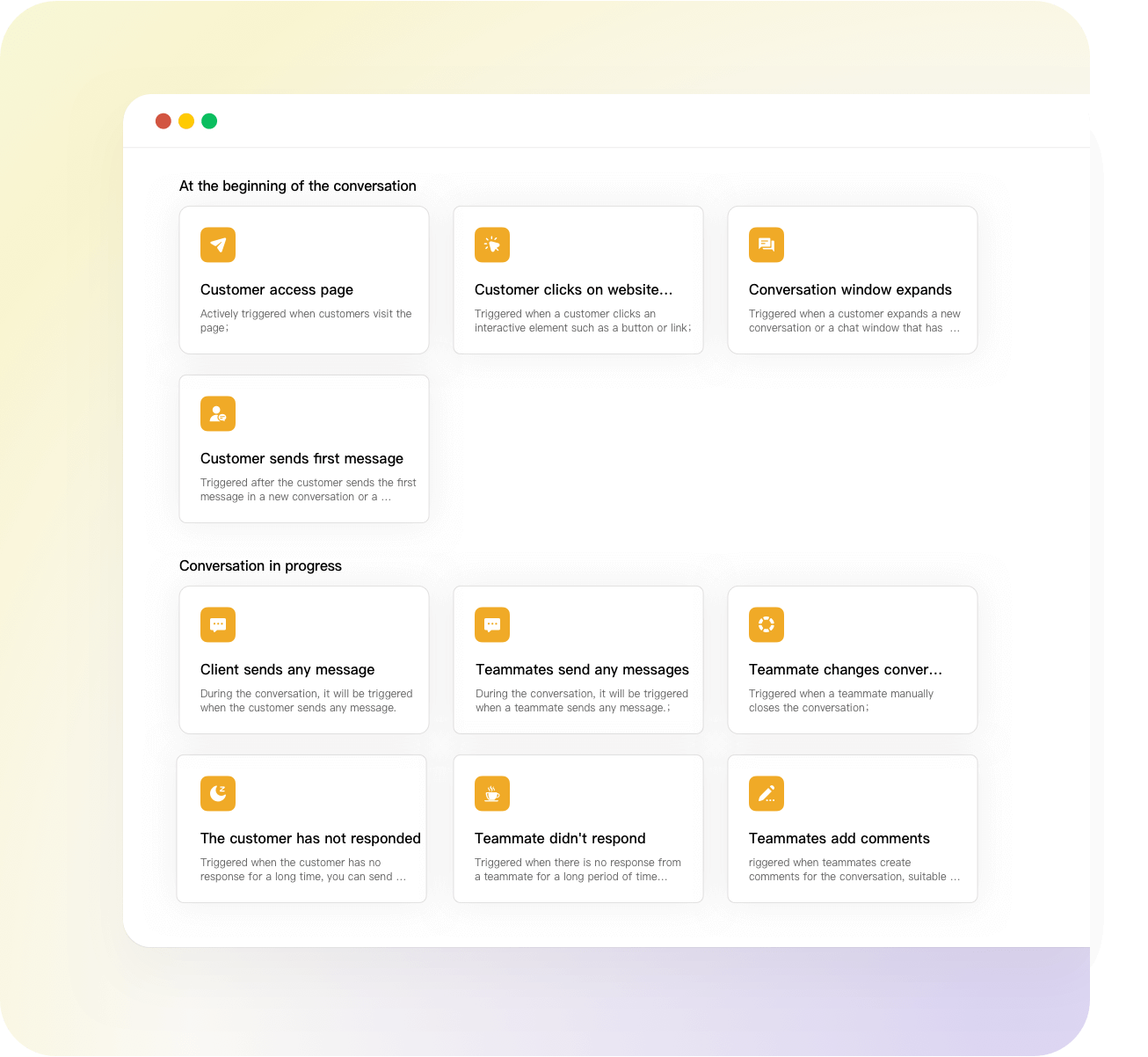Smart processes make customer onboarding easier
The birth of ByteTrack's intelligent process has made traditional customer service look new at the customer reception level.
Traditional customer service reception is insufficient
With the rapid development of network technology, the focus of people's lives has gradually shifted to online. Online life has brought us many conveniences, but it has also brought new challenges and problems. Among the many challenges, the field of online customer service stands out. A series of problems such as the huge number of consultations, the culture of different regions, and the different work and rest times put customer service staff under great pressure, resulting in difficulty in solving customer problems efficiently and inevitably affecting the corporate image. Here are some of the most frequently asked questions in customer reception:
1.Repeat questions: Most clients tend to ask similar or identical questions when they consult. Not only do these repetitive questions waste agent time, but they also lead to a degraded customer experience because every customer wants quick answers. However, the traditional customer service model is difficult to effectively manage and solve these repetitive problems, resulting in low customer service staff efficiency.
2.Long reception times: Reception times are often longer due to the fact that agents need to handle each customer's request on a case-by-case basis. In this case, the waiting time of customers will also increase accordingly, which will affect customer satisfaction and loyalty. Especially during peak periods, customer wait times can be significantly longer, further exacerbating the problem.
3.Slow problem solving: Traditional customer service systems lack intelligence and automation, resulting in relatively slow problem resolution. Agents rely on manually finding information and handling issues, which not only adds workload, but is also prone to errors and omissions.
Industry exploration solutions
Although many companies have taken the above problems seriously and actively explored solutions, they have achieved little in the end. At present, there are two kinds of solutions in the industry:
1.Voice customer service: By editing the problems that users may encounter in advance, guide users to match the corresponding problems through keystrokes.
2.Online customer service: Use preset buttons to guide users to solve problems independently.
The above two solutions have indeed brought some positive effects in practical applications, such as increasing the number of concurrent inquiries and reducing the pressure on customer service. However, the user experience suffers:
Lack of timeliness: Many preset problems are not time-sensitive and cannot solve the latest needs of users in a timely manner.
Lack of personalization: Each user is in a different environment, and preset solutions often fail to meet individual needs.
Single reply style: The fixed reply style makes the user feel difficult and inconvenient.
Difficulty finding a human agent: It can be difficult for users to quickly find a human agent when they need further help.
As a result of these shortcomings, there is an increasing number of criticisms from customers in the field of customer service. In order to completely solve this problem, ByteTrack innovatively combines customer service with intelligent processes to bring a new experience to traditional customer reception
Where intelligent processes come in
The intelligent process aims to break the traditional reception model, starting from the standardized process, trying to solve the dilemma of customer service staff being in a hurry after the increase in the number of inquiries. By using the visual editor to build the entire intelligent process, editors can operate without programming technology, making what you see is what you get. If the preset process needs to be adjusted, the customer service manager can directly modify the original process to ensure that the intelligent process remains time-sensitive.

Intelligent processes can be accessed in a variety of scenarios, and exclusive processes can be built according to different scenarios. In this way, customer service personnel can reduce repetitive work, quickly understand customer needs after the process in different scenarios is completed, grasp user pain points, and solve problems efficiently. Users can feel endless care in the process of use, and the trust and recognition of the enterprise will also be greatly improved.

Improving the user experience is a hallmark of intelligent processes. Intelligent processes can not only combine AI technology to provide personalized services based on user preferences and historical interactions, but also provide multiple formats such as images, links, and knowledge base documents when replying, helping users solve problems faster. If the user is not satisfied with the answer of the intelligent process, they can find the button to transfer to the manual at any time under the process reply, and match the customer service with one click to avoid cumbersome operations.
Overall, intelligent processes are of great significance in improving the customer service experience, especially when it comes to customer reception. It not only standardizes the reception process, but also combines a variety of features to make customer reception simpler and more efficient:
No threshold: The intelligent process is designed with the user's convenience in mind. With a simple and intuitive user interface, even managers with no programming experience can easily get started. Enterprises can quickly deploy and use intelligent processes without the need for complex technical training, which saves a lot of time and labor costs. No matter the size of your business, you can quickly enjoy the efficiency and convenience of intelligent processes.
Visualization: Intelligent processes use a visual editor to make process design and adjustment intuitive and easy to understand. Managers can easily build and optimize customer service processes with drag-and-click and click-and-click. This design not only improves work efficiency, but also reduces the error rate. The visual flow chart makes each step clear at a glance, ensuring that all links are closely connected for efficient customer reception.
AI Bonus: Intelligent processes incorporate advanced AI technology to make the customer service system smarter and more flexible. AI can analyze customer needs in real time, provide personalized solutions, and continuously learn and optimize its own response strategies. Through intelligent recommendations and automated replies, AI can quickly resolve common issues and reduce the workload of customer service staff. At the same time, AI can help identify and deal with complex issues, ensuring that every customer receives a satisfactory answer.
ByteTrack other solutions
As an industry-leading customer service system developer, ByteTrack has long been committed to improving the communication experience between enterprises and users. With AI as the core driving force, multiple products are integrated together to create a simple one-stop smart customer service platform.
Intelligent processes define customer hospitality behaviors, and digital employees are key to helping businesses increase productivity. Digital employees can take on customers 24 hours a day and have a strong learning ability. The longer a business is used, the more digital employees can understand the business and answer questions more professionally. At the same time, digital employees can be arranged to take over the conversation at any time according to the needs of the intelligent process, so as to achieve a seamless connection between the two and further improve the user experience.
The knowledge base and AI translation make customer service more professional. Enterprises only need to edit the knowledge documents in advance, whether in the intelligent process or conversational communication, they can easily call and show the expertise and details. AI translation enables communication without language barriers, and enterprises can set up different intelligent processes according to different languages, reflecting the best practices of humanistic care. At the same time, AI translation can also help human customer service communicate smoothly with customers from all over the world, which greatly demonstrates the business capabilities of enterprises.
brief summary
ByteTrack's intelligent processes have not only revolutionized the way traditional customer service works, but also significantly improved the customer experience. Through standardized, intelligent and flexible process management, the company not only improves work efficiency, but also wins the trust and recognition of customers. This innovative achievement undoubtedly provides strong support for modern enterprises in the fierce market competition.














One-stop solution, providing comprehensive support for business operations
ByteTrack,create a one-stop AI-based intelligent operational collaboration platform for you
- Resource
- ByteTrack academy
- Help center
- Developer center
- Contact us
-
 WeChat Official Account
WeChat Official Account Business WeChat ID
Business WeChat ID


 share
share


